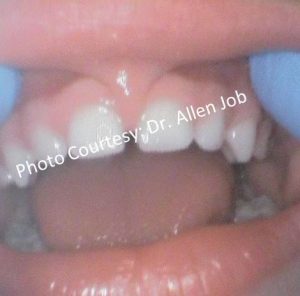Baby Steps Series: Tongue Tie and Lip Tie Laser Treatment
November 1st, 2017
 What is a tongue tie?
What is a tongue tie?
A tongue tie or ankyloglossia occurs when there is an abnormal band of thick tissue, also known as the frenum, which is located below the tongue.
How does a tongue tie affect feeding of newborn babies?
A tongue tie prevents the tongue from having the full range of motion. This is considered a developmental problem since it arises before a baby is born. Tongue tie restricts how a newborn nurses, often causing improper latch with the mother’s nipple.
What other problems can arise from having a tongue tie?
Having a tongue tie can create speech difficulties, malocclusion, and gum recession.1
Is having a tongue tie pretty common?
Tongue tie occurs between 4% - 10.7% of the population.2
Are there different types of tongue tie?
Anterior Tongue Tie
Yes, there are two primary forms of tongue ties complete and partial.3 When the frenum has limited tongue movement it is considered a partial ankyloglossia. This is known as an anterior tongue tie. Often, one can see an anterior tongue tie since it appears as a thin band of tissue under the tongue.
Posterior Tongue Tie
However, if the tongue appears to be fused to the floor of the mouth it is then considered to be a total ankyloglossia. This is known as a posterior tongue tie. Posterior tongue ties are much harder to visualize. The tongue has to be elevated from the floor of the mouth in order to diagnose a posterior tongue tie.
What is a lip tie?
An upper lip tie is present when the upper lip is lifted and the band of connective tissue (frenum) is tight, causing the gums to blanch (turn white). There are four classifications for lip tie, ranging from mild (Class 1) to severe (Class 4).
What are the 4 classifications of Lip Tie?
Class I: Mucosal
Class 2: Gingival
Class 3: Papillary
Class 4: Papilla Penetrating
Upper Lip, Lower Lip, and Tongue Ties. Can someone have more than 1 lip tie?
A lip tie can occur on either, the upper lip, the lower lip, or both. Often a lip tie accompanies a tongue tie.
How does a lip tie affect a baby?
Lip ties can be associated with breastfeeding difficulties in infants.4 They can be associated with facial cervical caries (tooth decay at the gumline), due to interference with proper oral hygiene.5 Moreover, they can also be associated with the gum recession. 6
How are tongue and lip ties treated?
Physicians, such as an ENT (Ear Nose Throat Specialist), usually will treat tongue and lip ties with a scalpel or surgical scissors. They may also require treatment to be completed with some form of sedation, ranging from local anesthetic to general anesthesia. Sutures or stitches may also need to be placed.
Today, pediatric dentists and some physicians trained in treating tongue tie and lip ties can perform this procedure in an outpatient setting, using a laser. With using a laser, there is less pain, less bleeding, and no need for sutures. This translates to faster healing and in most cases quicker resolution to the problem. This form of treatment usually requires using just a topical anesthetic and occasionally, a local anesthetic.
How long does the procedure take?
The procedure usually takes less than 10 minutes from start to finish. Mothers are able to nurse right after procedure with their infant.
What happens after the procedure?
In order to get optimal results and to ensure proper healing, it is essential that parents complete the post treatment therapy exercises with their infant and also follow-up with a daily oral hygiene routine. Moreover, a series of follow-up care appointments will be setup to monitor the healing process.
What about older children or adults?
Older children and adults can also benefit from lip tie and tongue tie correction. The benefits include: improved oral hygiene, decreasing orthodontic severity especially from lip tie treatment, and improved speech.
If your child is showing signs of tongue tie or lip tie, contact Dr. Allen Job at All Smiles Pediatric Dentistry, to for a comprehensive evaluation to see if your child will be a good candidate for laser treatment.
References
- Segal L, Stephenson R, Dawes M, Feldman P. Prevalence, diagnosis, and treatment of ankyloglossia. Can Fam Physician 2007;53(6):1027-33
- Boutsi EZ, Tatakis DN. Maxillary labial frenum attachment in children. Int J Paediatr Dent 2011;21(4):284-8.
- McDonald RE, Avery DR, Weddell JA. Gingivitis and periodontal disease. In: Dean JA, Avery DR, McDonald RE, eds. McDonald and Avery’s Dentistry for the Child and Adolescent. 9th ed. Maryland Heights, Mo: Mosby Elsevier; 2011:389-91.
- Coryllos E, Genna CW, Salloum A. Congenital tongue-tie and its impact on breastfeeding. Breastfeeding: Best for baby and mother. Am Acad Pedia (newsletter) 2004; Summer:1-7.
- Kotlow L. The influence of the maxillary frenum on the development and pattern of dental caries on anterior teeth in breastfeeding infants: Prevention, diagnosis, and treatment. J Hum Lact 2010;26(3):304-8.
- Minsk L. The frenectomy as an adjunct to periodontal Compend Contin Educ Dent 2002;23(5): 424-6, 428.
*This blog is part of the Baby Steps Series. Look for future blogs in this series.




